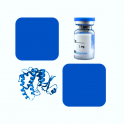
- Remove this product from my favorite's list.
- Add this product to my list of favorites.
Products
Viewed products
Newsletter
 |  |  |  |  |  |

Background
Cluster of differentiation 23 (CD23) is also known as Low affinity immunoglobulin epsilon Fc receptor (FCER2), C-type lectin domain family 4 member J (CLEC4J), Fc-epsilon-RII (FcεRII), Immunoglobulin E-binding factor (IGEBF), is the "low-affinity" receptor for IgE, an antibody isotype involved in allergy and resistance to parasites, and is important in regulation of IgE levels. Unlike many of the antibody receptors, CD23 is a C-type lectin. It is found on mature B cells, activated macrophages, eosinophils, follicular dendritic cells, and platelets.There are two forms of CD23: CD23a and CD23b. CD23a is present on follicular B cells, whereas CD23b requires IL-4 to be expressed on T-cells, monocytes, Langerhans cells, eosinophils, and macrophages. CD23 is known to have role of transportation in antibody feedback regulation. Antigen that enters the blood stream is captured by antigen specific IgE antibodies. The IgE immune complexes that are formed bind to CD23 molecules on B cells, and are transported to the B cell follicles of the spleen. The antigen is then transferred from CD23+ B cells to CD11c+ antigen presenting cells. The CD11c+ cells in turn present the antigen to CD4+ T cells, which can lead to an enhanced antibody response. In flow cytometry, CD23 is helpful in the differentiation of chronic lymphocytic leukemia (CD23-positive) from mantle cell leukemia (CD23-negative).
Source
Recombinant Biotinylated Human CD23, His,Avitag (CD3-H82Q5) is expressed from human 293 cells (HEK293). It contains AA Asp 48 - Ser 321 (Accession # P06734-1).
Predicted N-terminus: His
Molecular Characterization
This protein carries a polyhistidine tag at the N-terminus, followed by an Avi tag (Avitag™).
The protein has a calculated MW of 34.2 kDa. The protein migrates as 40-46 kDa under reducing (R) condition (SDS-PAGE) due to glycosylation.
Biotinylation
Biotinylation of this product is performed using Avitag™ technology. Briefly, the single lysine residue in the Avitag is enzymatically labeled with biotin.
Biotin:Protein Ratio
Passed as determined by the HABA assay / binding ELISA.
Endotoxin
Less than 1.0 EU per μg by the LAL method.
Purity
>95% as determined by SDS-PAGE.
>90% as determined by SEC-MALS.
Formulation
Lyophilized from 0.22 μm filtered solution in PBS, pH7.4 with trehalose as protectant.
Reconstitution
See Certificate of Analysis for details of reconstitution instruction and specific concentration.
Storage
For long term storage, the product should be stored at lyophilized state at -20°C or lower.
Please avoid repeated freeze-thaw cycles.
This product is stable after storage at:
-20°C to -70°C for 12 months in lyophilized state;
-70°C for 12 months under sterile conditions after reconstitution.
Bioactivity
Please refer to product data sheet.
(1) "Associations of A20, CYLD, Cezanne and JAK2 Genes and Immunophenotype with Psoriasis Susceptibility"
Giang, Lien, Trang et al
Medicina (Kaunas) (2023) 59 (10)
(2) "Primary hepatic undiferentiated pleomorphic sarcoma co-existed with hepatocellular carcinoma"
Qu, Cao, Zhang et al
Rev Esp Enferm Dig (2023)
(3) "Molecular Characterization of Primary Mediastinal Large B-Cell Lymphomas"
Donzel, Pesce, Trecourt et al
Cancers (Basel) (2023) 15 (19)
Showing 1-3 of 3399 papers.
(1) "A SARS-CoV-2 neutralizing antibody with extensive Spike binding coverage and modified for optimal therapeutic outcomes"
Authors: Guo Y, Huang L, Zhang G, et al.
Journal: Nature communications 2021
Application: ELISA
Follow us